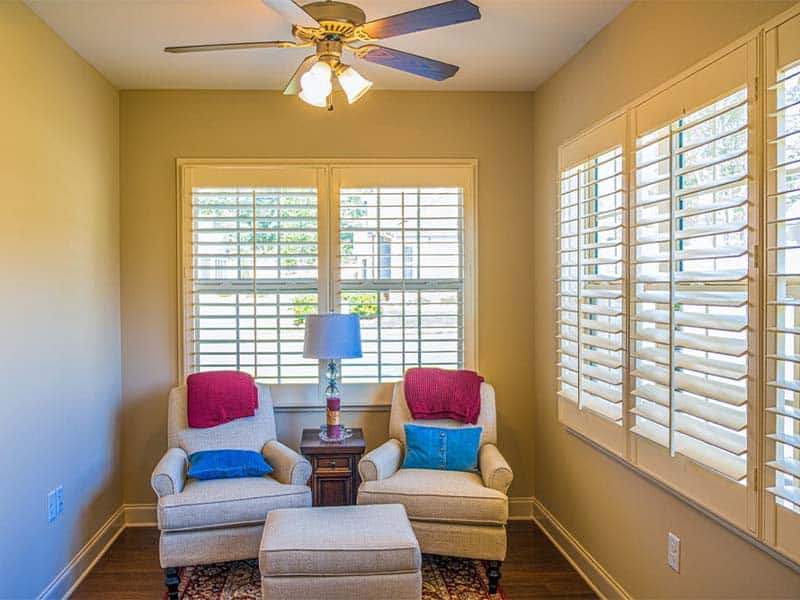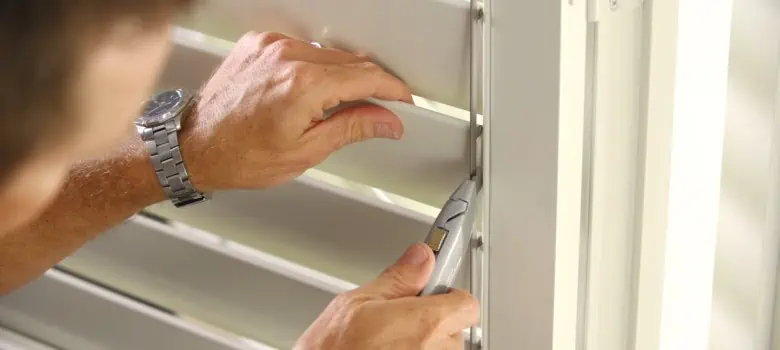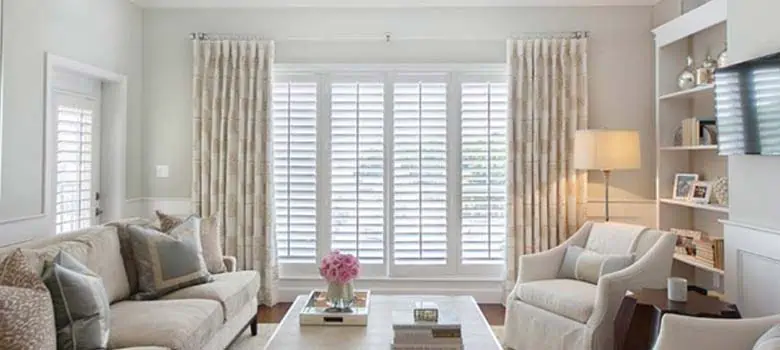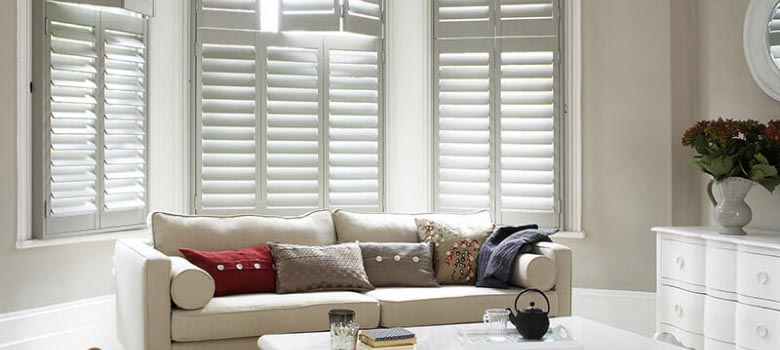If privacy is a priority, then you can’t go wrong with plantation shutters vs blinds. But these window treatments are not one and the same. You’ll want to make sure you’re familiar with all of the differences, including the costs, before making a decision for your Brisbane home.
Whether you’re after lower energy bills, elevated style, or protection from sun, there are plenty of reasons to add window treatments to your home – and there’s certainly no shortage of options to choose from.
All of the different styles, materials, and colours make your imagination the only limit.
Then again, having too many choices can confuse matters quite a bit. And let’s face it, creativity can sometimes get in the way of practicality (and your budget).
Are you looking to simply decorate a space or for options that allow for privacy, light control, and even protection from the hot summer heat?
If you’re feeling overwhelmed, remember that design aesthetics are just as important as function. You’ll see your new window coverings every day, so factor this alongside your size, budget, and objective.
We’re going to take a super close look at both types in a head-to-head showdown: plantation shutters vs blinds. In the end, you’ll be able to choose the best option for your home.
What makes plantation shutters and blinds different?
On a basic level, they can seem fairly similar.
They both provide a decent amount of privacy and light control for the windows they cover. But the similarities end there.
#1: Form factor
Plantation shutters are known for their rigid, solid structure and tilted louvres. These allow homeowners to control the amount of light that enters the home. The louvres can be adjusted in different directions, or the actual shutter can swing open on a hinge (similar to a door).
Blinds come in a variety of styles with different control systems, none of which are necessarily louvres. Vertical options, for example, run on a track and are made up of (you guessed it) vertical slats. Venetians use horizontal slats that can be raised or tilted usually using a cord.
#2: Installation
Both window treatments are permanently affixed to your windows. But how they are installed is quite different.
Plantation shutters include a frame that is attached directly to the window frame. This gives them more stability. They are also hinged with an inside mount, which makes it easy for them to swing open.
Blinds, on the other hand, have a variety of install methods depending on the specific type. Vertical variations come with a track that must be mounted and given space for the panels to slide along. Venetian and other varieties of horizontal options are installed with either an inside or outside mount depending on the style and fit of your windows.
#3: Fit
Blinds can be much more forgiving when it comes to an exact fit. If you are off by a few millimeters, you can still hang them, but you might have a small gap or rays of light sneaking through.
In contrast, plantation shutters require an exact fit. Mismeasure and you won’t be able to hang the frame within your window frame. They won’t open and close properly or could bang into one another.
#4: Material
When it comes to what the window treatments are actually made of, you’ll probably see more options with blinds. Their design allows for use of fabrics, for example, that simply wouldn’t work with plantation shutters. Of course, fabrics are much less durable, but we’ll get to that.
Blinds can be made out of:
- Natural Wood
- Engineered Wood
- PVC / Vinyl
- Plastic
- Metal
- Synthetic Insulating Fabric
- Natural Fabric
Whereas you can find shutters made from:
- Natural Timber
- PVC (with metal core)
- Aluminum
With their more sturdy construction and thicker materials, they also tend to do a better job at keeping out light and reducing how much heat enters your home – which is a major consideration for Brisbane homeowners dealing with the summer heat.
Thinking about refreshing the look of your home? Check out our range of plantation shutters.
What to consider when comparing these two options
Here’s the bad news – there’s no simple answer to which window treatment is a better choice for your home as everyone’s needs (and windows) are different, after all.
OK, now for the good news – we’ve created a comparison guide so you can keep score at home and choose what’s best for you.
Material options
As we listed above, blinds will have more options when it comes to materials. This comes down to the fact that their less rigid design allows for lighter weight metals, plastics, and fabrics.
The downside here can be durability. While fabrics can look amazing and color coordinate exactly with your chair cushions, they can wear down and fade over time.
They’re also less easy to clean, but we’re getting ahead of ourselves again.
Price
When comparing the cost of plantation shutters vs blinds, first option will generally be more expensive. This is because they are made of more material and sturdier materials. They are also more intensive to install and usually come custom measured and custom made.
The table below will give you a quick idea of average costs. This does not include extras like custom colors, for example.
| Window Treatment | Average Cost per m2 |
|---|---|
| PVC Plantation Shutters | $500-600 |
| Timber Plantation Shutters | $700-800 |
| Aluminum Vertical Blinds | $40-80 |
| Vinyl Vertical Blinds | $20-40 |
* Pricing is based on average pricing in Australia and is subject to change.
Get more resources here:
-
- How Much Do Plantation Shutters Cost in Brisbane?
- What Is The Best Material For Plantation Shutters?
- How to Choose the Right Plantation Shutters Colour
- What Are The Pros And Cons Of Plantation Shutters?
- 5 Common Plantation Shutter Problems And How To Fix Them
- Can You Put Plantation Shutters On Sliding Doors?
- What to Consider When Buying Living Room Plantation Shutters
- How To Clean Plantation Shutters
- Why White Plantation Shutters Are The Most Popular Choice
- The Step by Step Guide to Installing Plantation Shutters
- Everything You Need To Know About Plantation Shutters
Installation
Your best bet is to have your window treatments professionally installed, regardless of your choice. You can try to DIY the project, but you will be much more likely to damage your window frame.
Professional installers will also pre-measure your window to make sure they fit properly before you place an order.
That said, installation costs will be higher for plantation shutters. They are just a bit more involved and require finesse to ensure they are level, square to the frame, and working right. Look for them to cost $50 to $70 to install per panel.
You can compare this to vertical options, for example, which cost anywhere from $30 to $80 to install for an entire window.
Durability
This comes down to material and design, and plantation shutters usually shine here. They have a solid frame that is affixed directly to the window frame, making it a long-lasting solution. There are few moving parts, aside from the hinges and louvres, so you don’t have to worry about wear.
Blinds tend to be less long-lasting. For one, they have a lot more moving parts. Vertical solutions have a track and each piece has to run across properly. Venetians have cords and pulleys that not only open but retract the blind. And for items like roller options, fabrics can wear, fray, and fade.
Maintenance
Both options should be low maintenance. If you go with fabric blinds, you’ll find them more difficult to keep clean and they’ll be more likely to trap dust. However, either option made from wood, synthetics, PVC, or metals will wipe clean.
Plantation shutters are a popular choice because they can remain closed while you tilt the louvres to control how much light enters a space. They can also let in a bit of sun while maintaining most of your privacy.
Privacy comes down to the type and design. Vertical optins lose their privacy when you open them up to let the light in. Fabric blinds are usually either room darkening or light filtering, which gives you less control as the light and your needs change throughout the day.
FKR GROUP TIP: Light control can also come down to thermal protection. The more light you let in, the warmer your space can become. For this reason, shutters are also more popular in homes that want to cut down on how much heat, not just light, from the sun enters their space.
Can you install plantation shutters on every window?
They are a popular window covering option in modern Brisbane homes. But can you install them on every single window in your house?
From a design standpoint, they have a distinct look. It’s typically recommended that if you use them on one window in a room, you install the same window coverings throughout the room for aesthetic purposes.
In terms of the mount, there are many options available including:
- Hinged
- Fixed
- Bay
- Corner
- Bi-Folds
- Sliding
- Raked
- Double Raked
- Tier on Tier
For example, some homeowners choose to go for a look where all of the windows on the same storey or frontage of a house have shutters for curb appeal.
Budget, however, can get in the way here. Be sure to have your home measured out and consult with a professional installer. You can also get creative with options such as half-length or café style window treatment that cover the lower half of a window.
One way to minimise your costs is to combine two window treatments of the same material. For example, you can use timber on windows where design or light control matters most to you. Then go with wood in a similar timber and finish on the rest of your windows. They’ll coordinate with one another while giving your budget a breather.
How shutters add value to a home
Where do we start?
Firstly, you’ll reap the rewards of privacy, light control, thermal protection, and beautiful design. But they are also a popular option in Australia right now, helping you beautify your home for as long as you live in it (and attracting future buyers).
As they are attached to your home as part of the installation, they’re usually custom measured to fit your specific windows. This adds value to your home for the long term as buyers are likely to see this as an upgrade to their living space.
After all, since they don’t have to go through the process of installation, they can enjoy all the benefits with none of the cost.
Mixing design: using shutters with other window treatments
One of their perks is that they essentially eliminate the need for additional window coverings.
Also, depending on how they are installed or the shape of your window and frame, there may not be much room to add anything.
If you’re looking to get creative with your combinations, here are some design considerations for you. Keep in mind that using more neural colors can give you more flexibility now and in the future as your preferences change.
- Curtains: You can hang curtains on rods higher than the window itself to soften the look of the space. Just be sure that they can be drawn back far enough to properly open the other window coverings as needed.
- Valances: These decorative options can add drama to a window, but you have to be careful. If they come down too low, they will block the movement of other window coverings. These could be a good combination for a window with only a half-height shutter, too.
- Blinds: While you wouldn’t use these together on the same window, we noted above how you can use them with similar color or wood in a room that also has other window treatment.
How to install the right window coverings in your Brisbane home
When comparing plantation shutters vs blinds, the choice is simply a matter of preference.
Both options can add design elements to a space while also giving you light control and privacy.
Be sure to review all of the differences and consider what matters most to you. In some cases, budget will dictate design, but you can creatively use different yet complementary window treatments in the same room to achieve the right look.
Since the installation method really makes these two options different, make sure your existing window frame can accommodate the option you want. In some cases, you may not have enough space to install a frame or attach hinges and tracks as needed.
Let the pros at FKR Group help you choose and install the best window treatments for your home. Our experts have over 30 years of experience as shutter and blind specialists, so you’ll be in great hands. All of our installs are custom made and backed by both product and installation warranties.
We’ll measure your space and make recommendations that will fit your home, style and budget. Just call us on 0412 872 822 or request a fast free quote today to get started.
| Plantation Shutters | Blinds |
|---|---|
| Rigid, solid structure and tilted louvres. | Variety of styles with different control systems. |
| Installation includes a frame that is attached directly to the window frame. | Variety of installation methods. |
| Require an exact fit. | Much more forgiving when it comes to an exact fit. |
| Timber, PVC, aluminium. | Natural wood, engineered wood, PVC, plastic, metal, synthetic, natural fabric. |



![How to Choose the Right Plantation Shutters Colour [Simple Guide] 4 How to choose the right plantation shutters colour](https://www.fkrgroup.com.au/wp-content/uploads/2022/08/How-to-choose-the-right-plantation-shutters-colour-01.jpg)
